

Australian History Timeline: From pre-1770s to 2000s. Cathy Freeman wins 400m gold - On This Day September 25. Port Arthur massacre and firearms laws in Australia - National Museum of Australia. Road to change After the massacre, the recently elected Coalition federal government decided to work towards engaging the states and territories to enact identical gun laws.

This move was an attempt to ensure there would never again be another event like Port Arthur in Australia. The new legislation would involve a ban on firearms that were fully automatic, semi-automatic (such as those used at Port Arthur), pump-action and self-loading. Gold Nugget 'Welcome Stranger' (1869) - Museums Victoria. CULTURAL SENSITIVITY MESSAGE – Please read First Peoples of Australia should be aware that the Museums Victoria Collections website contains images, voices or names of deceased persons.

For some First Peoples communities, seeing images or hearing recordings of persons who have passed, may cause sadness or distress and, in some cases, offense. Language Certain records contain language or include depictions that are insensitive, disrespectful, offensive or racist. This material reflects the creator’s attitude or that of the period in which the item was written, recorded, collected or catalogued. Eureka Stockade. Conflict in the goldfields Starting in 1853, miners began to gather in ‘monster’ meetings to voice their complaints, and delegations presented their concerns to Governor La Trobe, but he was unreceptive to the requests.
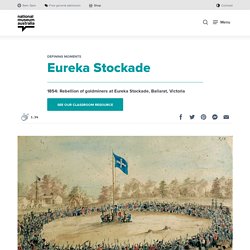
Many of the diggers were politically engaged – some had participated in the Chartist movement for political reform in Britain during the 1830s and 1840s while others had been involved in the anti-authoritarian revolutions that spread across Europe in 1848. The situation on the goldfields was tense as police regularly ran ‘licence hunts’ to track down diggers who hadn’t paid their fees. The miners claimed the police were extorting money, accepting bribes and imprisoning people without due process.
On 6 October 1854 the Scottish miner James Scobie was killed in an altercation at the Eureka Hotel in Ballarat. Defining moments: Eureka Stockade - National Museum of Australia. Women and the Eureka Stockade. Hare in trap, 1946 by Sidney Nolan - Art Gallery of NSW. Brian Adams, Sidney Nolan: such is life, Melbourne, 1987, 190.
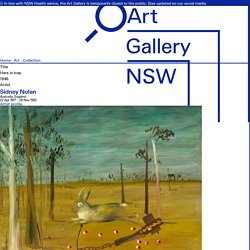
Sir Kenneth Clark, Bryan Robertson and Colin MacInnes, Sidney Nolan, London, 1961, (illus.). plate no. 3 Sir Kenneth Clark, Sidney Nolan, Folkestone, 1970, (illus.). cat.no. 14; Lent by V.C. Nolan Contemporary Art Society (New South Wales), Eighth Annual Exhibition: Contemporary Art Society (1946), Sydney, 1946. cat.no. 270; priced 60 gns Our art critic, The Sydney Morning Herald, 'Contemporary art more conservative', pg 5, Sydney, 12 Nov 1946, unknown.
Review of CAS 8th annual exhibition. Richard Ingleby., The independent, 'Visual Arts: Nolans Nolans, Agnew's Gallery, London', London, 17 Jun 1997. Waltzing Matilda. Dawn of the legend: The A.I.F. - Australian War Memorial. The Australian Imperial Force, first raised in 1914 for overseas war service, became better known by its initials – the “AIF”.

It was a separate and purely volunteer army. There was a distinct character to those who enlisted in the earliest months and who were destined to fight on Gallipoli. They were keen; they had to meet tougher physical standards than those later applied; and quite a few had previous experience in British or Australian forces. Each of them would need to be lucky to survive the next four years of war.
Training and departure of the First A.I.F - Film Collection Online. National Apology - National Museum of Australia. Submissions to the Inquiry The inquiry took evidence personally from 535 Indigenous people and received hundreds of letters and testimonies from other people.
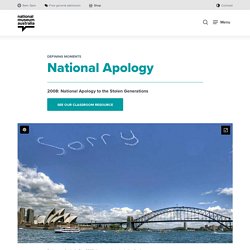
It also recognised that there were many who could have provided evidence but did not do so because they were unable to travel, uncomfortable with the public nature of the inquiry, or still too frightened or traumatised to speak of their experiences. Mabo Day & Native Title: Who was Eddie Mabo & what is his legacy? - Behind the News. How was Australia named?: New Holland - National Library of Australia. Matthew Flinders (1774-1814), General chart of Terra Australis or Australia : showing the parts explored between 1798 and 1803 by M.
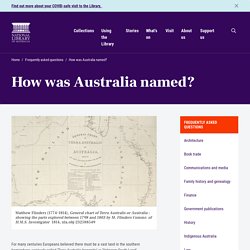
Flinders Commr. of H.M.S. Investigator 1814, nla.obj-232588549 For many centuries Europeans believed there must be a vast land in the southern hemisphere, variously called ‘Terra Australis Incognita’ or ‘Unknown South Land’. Australia's migration history timeline. Objects through Time traces the history of migration of people, technology and ideas to our shores through a collection significant objects, spanning a 60,000 year time frame.
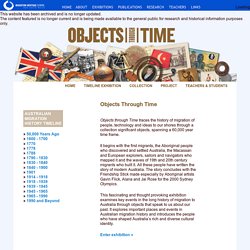
It begins with the first migrants, the Aboriginal people who discovered and settled Australia, the Macassan and European explorers, sailors and navigators who mapped it and the waves of 19th and 20th century migrants who built it. All these people have written the story of modern Australia. The story concludes with the Friendship Stick made especially by Aboriginal artists Gavin Flick, Alana and Jai Rose for the 2000 Sydney Olympics. This fascinating and thought provoking exhibition examines key events in the long history of migration to Australia through objects that speak to us about our past.
It explores important places and events in Australian migration history and introduces the people who have shaped Australia’s rich and diverse cultural identity. Home - 80 Days That Changed Our Lives - ABC Archives. Biography: Edward Hammond Hargraves - Australian Dictionary of Biography. Edward Hammond Hargraves (1816-1891), gold rush publicist, was born on 7 October 1816 at Gosport, Hampshire, England, son of Lieutenant John Edward Hargraves and his wife Elizabeth, née Whitcombe.

Educated at Brighton Grammar School and Lewes, he went to sea at 14 and arrived at Sydney in 1832. He worked on a property at Bathurst, gathered bêche-de-mer and tortoise shell in Torres Strait and in 1834 took up 100 acres (40 ha) near Wollongong. In 1836 at Sydney he married Elizabeth, née Mackay. In 1839 they moved to East Gosford where he became an agent for the General Steam Navigation Co. and with her dowry bought land and built the Fox under the Hill Hotel. My Place for teachers. In February 1851, Edward Hargraves discovered gold near Bathurst, New South Wales.

A few months later, gold was discovered in Victoria, first at Clunes and later at Buninyong, Ballarat, Castlemaine and Bendigo. During this era, the gold bullion that was shipped to London brought back a huge flow of imports. Everyday life in the cities was disrupted as men left their jobs and families to seek their fortune on the goldfields. Indigenous referendum - National Museum of Australia. Getting organised The Aborigines Advancement League (AAL) and the New South Wales Aborigines’ Progressive Association (APA) staged a Day of Mourning on Australia Day 1938, the sesquicentenary of British settlement, in commemoration of what activist William Cooper called, ‘the whitemans [sic] seizure of our country’. It was one of the first overtly political actions to highlight the plight of Aboriginal people. Footage of the Australian Referendum (1967) silent - ABC News. Canberra. Things to Do - Australian Parliament House, Canberra. Australian Institute of Sport.
Skip to content Australian Institute of Sport AIS 40th anniversary readspeaker Sharethis Facebook Linkedin Twitter email ListenReadSpeaker webReader: Listen. Questacon - The National Science and Technology Centre. What is Australia's national identity - Monash Lens. Trying to define national identity is like searching for the end of a rainbow. It isn’t something that can be found or a place we can collectively reach; it’s something that unfolds over time and through generations. It’s also something that is contested and evokes a sense of belonging individually. “I think national identity, like so many ways that we like to think about ourselves, is very much a generalisation of a particular moment,” says Ruth Morgan, a senior research fellow from Monash University’s School of Philosophical Historical and International Studies.
1778: Australia's migration history timeline - NSW Migration Heritage Centre. Black-eyed Sue and Sweet Poll of Plymouth taking leave of their lovers who are going to Botany Bay, Robert Sayer, 1792. Courtesy National Library of Australia By the 1790s British Investors were purchasing 38,000 slaves a year. Why did Europeans settle in Australia? History - British History in depth: Beneath the Surface: A Country of Two Nations. Convict hulks - Sydney Living Museums. Skip to main content Mobile Menu Search form Hyde Park Barracks.
British Prison Hulks - Old Police Cells Museum. Industrial Revolution: Definitions, Causes & Inventions - HISTORY. Industrial Revolution: Definition, Facts, & Summary - Britannica.
Steve Irwin. Our national identity.